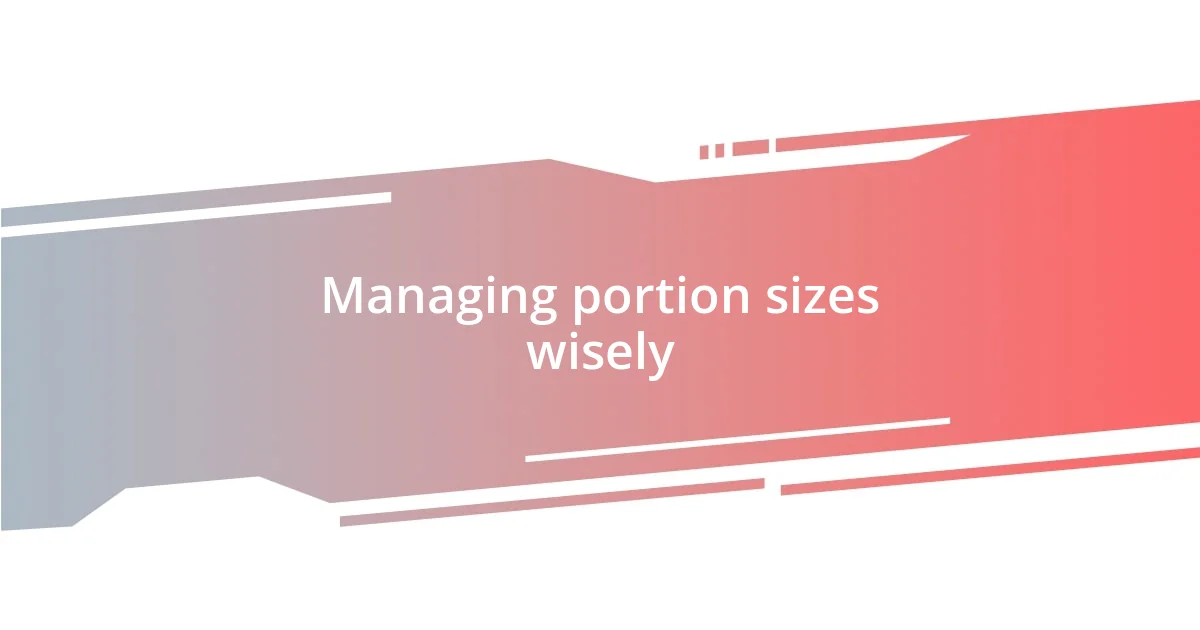Key takeaways:
- Recognizing personal dietary needs and listening to the body’s signals is crucial for creating an authentic nutrition plan.
- Establishing clear and specific nutrition goals, such as increasing water intake and trying new recipes, enhances accountability and motivates positive dietary changes.
- Incorporating whole foods into meals, balancing macronutrients, managing portion sizes, and staying hydrated significantly improve overall well-being and energy levels.

Understanding personal dietary needs
Understanding my personal dietary needs has been a journey filled with discovery and self-awareness. For instance, I realized that dairy, which I previously enjoyed, often left me feeling bloated and uncomfortable. Have you ever experienced something similar? Recognizing that this was a signal from my body made me rethink my daily choices.
As I dove deeper, I found that my energy levels fluctuated significantly depending on my carbohydrate intake. I vividly remember a day when I had a heavy pasta lunch; by mid-afternoon, I felt utterly drained. Reflecting on those moments helped me fine-tune my diet, realizing that moderate portions and the right type of carbs were crucial for sustaining my energy.
Listening to my body became a vital lesson in understanding my dietary needs. Whenever I experimented with new foods, I closely observed how I felt afterward. It’s fascinating how our bodies communicate their requirements. Do you pay attention to how different foods impact your mood and energy? I now take those signals seriously, blending intuition with knowledge to create a nutrition plan that feels authentic to me.

Establishing clear nutrition goals
Establishing clear nutrition goals has been transformative for me. Initially, I set vague targets, like “eating healthier” or “losing weight,” but these felt overwhelming and often unattainable. It wasn’t until I specified my goals—such as “incorporating two servings of vegetables in every meal”—that I started seeing real progress. I found it motivating to track small victories along the way, like trying a new vegetable or discovering a protein-packed recipe.
One experience that stands out was when I set a goal to increase my water intake to help with digestion. I decided to aim for eight glasses a day and tracked my progress with a fun app. By the end of the week, not only did I feel more hydrated, but I also noticed an improvement in my skin’s appearance. It made me realize how much setting tangible, measurable goals enhances accountability and encourages positive habits.
When I talk about clear nutrition goals, balancing enjoyment and health is essential. It’s not just about restrictions; it’s about expanding my palate. For example, I challenged myself to prepare one new healthy recipe each week. This goal didn’t just improve my cooking skills; it also made me excited about meal times again and helped me build a diverse and satisfying diet. Have you ever set a goal that transformed how you feel about food? Small, specific goals can lead to big changes over time.
| Vague Goals | Clear Goals |
|---|---|
| Eat healthier | Incorporate two servings of vegetables in every meal |
| Lose weight | Track daily caloric intake and exercise three times a week |
| Be more active | Walk at least 10,000 steps daily |
| Drink more water | Consume eight glasses a day |
| Try new foods | Prepare one new healthy recipe each week |

Incorporating whole foods daily
Incorporating whole foods into my daily diet has brought about a noticeable shift in my overall well-being. I still remember the first week I decided to swap processed snacks for fresh fruits and nuts. It felt like a small change, but by day three, I noticed an increase in my energy levels and even an improvement in my mood. I can’t emphasize enough how these natural foods fuel my body in a way that processed options never did.
Here are some strategies I’ve found effective for integrating whole foods seamlessly into my meals:
- Start each day with a breakfast rich in whole grains, like oatmeal topped with berries and nuts.
- Always keep fresh fruits and vegetables visible on the kitchen counter; it’s a gentle reminder to grab something nutritious.
- Prepare a big batch of a grain-based salad (like quinoa or brown rice) at the start of the week to enjoy throughout.
- Experiment with whole-food snacks, such as hummus with carrot sticks, instead of reaching for chips or candy.
- Involve my family in cooking with whole foods; preparing meals together has turned into a fun bonding activity!
Making these small shifts has not only made my meals more colorful but also enriched my connection with food. Have you ever noticed how a vibrant plate can lift your spirits? It’s all about making those intentional choices that resonate with me, and incorporated whole foods have truly transformed my relationship with eating.

Balancing macronutrients effectively
Balancing macronutrients effectively has been a game-changer for me. I remember the first time I took a close look at my meals and realized how often they were skewed toward carbs. I felt sluggish and wondered if there was a correlation. Once I set a goal to balance my macronutrients—aiming for a roughly equal portion of proteins, fats, and carbohydrates—I noticed a significant boost in my energy and overall mood. It was astonishing how adjusting these elements in my diet helped me feel more vibrant and alert.
One practical tip that transformed my approach was meal prepping. By dedicating an afternoon to prepare balanced meals for the week, I could ensure I was meeting my macronutrient goals. I would portion out combinations like grilled chicken with quinoa and roasted veggies, making it easy to grab and go. This not only saved me time during busy weekdays but also prevented me from defaulting to convenience foods that often miss the mark when it comes to balance. Have you ever considered how a bit of foresight can dramatically change your eating habits?
I find it fascinating how individual preferences can influence macronutrient balance. For instance, I love experimenting with healthy fats like avocado and olive oil, which not only improve the taste but also provide essential nutrients. The other day, I made a delicious avocado toast topped with a poached egg and a sprinkle of salt and pepper. It was satisfying and nourishing, epitomizing how the right balance can not only support my health but also bring joy to my meals. Have you explored how incorporating different macronutrients affects your energy levels and cravings?

Managing portion sizes wisely
When it comes to managing portion sizes wisely, I’ve learned that using smaller plates can be a surprisingly effective trick. I remember coming across this idea during a dinner party where everyone had their own petite dish. It felt sophisticated, yet I ended up serving myself less without even realizing it! This small change satisfied my love for variety while helping me control portions effortlessly.
I also make it a point to listen to my body and its hunger cues. There’s something empowering about recognizing when I’m truly hungry versus when I’m just bored or stressed. I once had a day filled with back-to-back meetings, and instead of mindlessly munching on snacks, I took a moment to step outside and breathe. That pause helped me press the reset button on my cravings, reminding me that mindful eating can be just as important as what’s on my plate.
Another strategy I adore is preparing my meals in advance, allowing me to portion them out thoughtfully. I find immense joy in planning my week ahead and packing my lunches into balanced servings. It turns into a mini event, almost like prepping for a fun project! This way, I’m not just giving my body what it needs but also creating a visually appealing meal that I look forward to enjoying. Have you ever considered how portioning out your meals could turn cooking into a delightful ritual instead of a chore?

Staying hydrated and its benefits
Staying hydrated is something I genuinely prioritize in my daily routine. I’ve come to realize that drinking enough water not only keeps my skin looking fresh but also sharpens my focus. Just the other day, I noticed a dip in my energy levels, and I quickly grabbed a glass of water. Sometimes, I catch myself mistaking thirst for hunger, which can throw off my eating habits. Have you ever felt that sudden headache or fatigue, only to find that a tall drink of water made all the difference?
There’s also a sense of satisfaction that comes from keeping a full water bottle by my side. I find it so motivating to see how much I have consumed throughout the day, almost like a small challenge. I remember when I first tried infusing my water with slices of lemon and mint. It turned this simple drink into something refreshing and exciting. The flavor kept me sipping away and made the whole process feel less like a chore. If you think about it, isn’t it remarkable how little changes can motivate us to stay hydrated?
Moreover, I love how hydration supports my workouts. Whenever I remember to drink water before hitting the gym, I notice a clear boost in my performance. I used to feel sluggish halfway through my routine, but now, I arrive pumped and ready to tackle those last reps. Staying hydrated has truly become part of my approach to nutrition and fitness. Have you thought about how enhancing your hydration can impact your physical performance and energy?

Tracking progress and adjusting plans
Tracking my progress and adjusting my plans is an essential part of my nutrition journey. I often jot down my meals and feelings in a journal, which helps me spot patterns over time. Just last month, I noticed I was craving carbs more than usual. Instead of dismissing it, I dove deeper and realized my workouts had intensified—an adjustment in my carbohydrate intake was necessary.
I’m a firm believer in adapting what doesn’t work. For instance, I once followed a meal plan that looked great on paper but left me feeling drained and unsatisfied. So, I decided to tweak it by adding more healthy fats and colorful veggies. The change was profound; not only did my energy return, but my meals became exciting again. Hasn’t everyone felt that boost of enthusiasm when trying something new?
Using visuals has also been a game-changer in tracking my progress. I love creating a vision board that reflects my goals and achievements. Each time I check off a milestone, I feel a sense of accomplishment that fuels my motivation. It’s fascinating how visually celebrating my wins keeps me aligned with my journey. Have you ever considered how small victories can ignite a powerful momentum for change?















